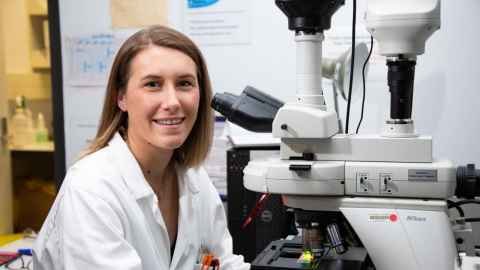Take 10 with... Molly Swanson
Dr Molly Swanson, Research Fellow with the School of Biological Sciences, gives us 10 minutes of her time to discuss her research on motor neuron disease.

1. Describe your research topic to us in 10 words or less.
Inflammation in human motor neuron disease brains.
2. Now explain it in everyday terms!
My current research focuses on understanding how the immune cells of the brain, called microglia, change in motor neuron disease. Microglia normally function to help the brain heal from damage and/or disease. There is increasing evidence that microglia become dysfunctional in neurodegenerative diseases, which can be toxic to neurons, thereby contributing to disease. Because of their potential to both help and harm the brain, understanding how microglia change in disease is key to developing potential therapies.
3. Describe some of your day-to-day research activities.
If I am working in the lab, I am usually labelling proteins in post-mortem tissues or imaging these sections on a microscope. I then spend a lot of time on my computer, optimising image analysis methods and analysing data.
4. What do you enjoy most about your research?
I really enjoy the problem solving required for my projects. I have the incredible privilege of using post-mortem human tissue from the Neurological Foundation Human Brain Bank in the Centre for Brain Research. This is a precious resource, so part of the challenge is getting the most information out of each single tissue section possible.
I develop image analysis pipelines that mean I not only quantify changes in microglia in post-mortem human tissue, but I also map these changes to anatomy and disease pathological proteins. Developing these pipelines is one of the most enjoyable aspects of my research. The problem solving involved is addictive and better yet, I know I am making the most of a precious resource.
5. Tell us something that has surprised or amused you in the course of your research.
I think the biggest surprise was the sense of community in my research environment. As individuals, we are constantly trying to get papers published and funding, but you are often competing against your colleagues. Despite this competition, the support my colleagues have for one another is incredible. It means we all work in a positive environment and it really does push us to do the best science possible.
6. How have you approached any challenges you’ve faced in your research?
I have tried to surround myself with like-minded researchers who can help me through any challenges. On days where I do not feel on top of my work, I have trusted co-workers who can help me.
The best example of this is when I have struggled with imposter syndrome. On the days where I have feelings of self-doubt, I am lucky enough to have co-workers cheering me on, believing in me and my research.
7. What questions have emerged as a result?
One of the biggest questions that has come out of my research is essentially how we can get more information from post-mortem tissues. I study microglia, but we also want to know how interactions between microglia and other cell types in the human brain are altered in motor neuron disease.
8. What kind of impact do you hope your research will have?
I hope that by identifying changes in neurodegenerative disease brains we will have a greater understanding the pathogenesis. This comprehensive understanding is key for the future development of therapies for diseases like motor neuron disease.
9. When collaborating across the faculty or University, or even outside the University, who do you work with and how does it benefit your research?
My research focuses on identifying changes in human motor neuron disease. To achieve this, I collaborate with Distinguished Professor Richard Faull, Professor Maurice Curtis, Professor Mike Dragunow, and their lab groups in the Centre for Brain Research. This is a highly collaborative environment and it really challenges me to do the best science possible.
I am also lucky enough to collaborate with Dr Adam Walker and his lab group from Queensland Brain Institute at the University of Queensland. Dr Walker’s lab works with a mouse model of motor neuron disease which I will compare to the human motor neuron disease brains from the Neurological Foundation Human Brain Bank.
10. What one piece of advice would you give your younger, less experienced research self?
Don’t question every step. Trust your instincts and just enjoy the journey. You can’t plan everything (even if you may want to).